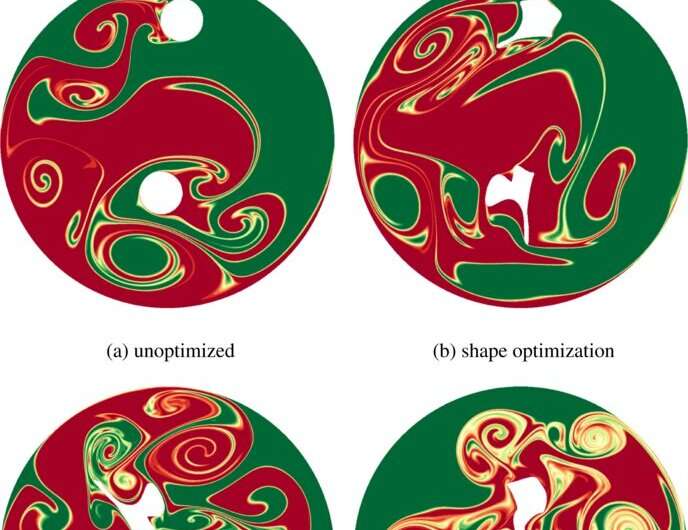Comparison of final snapshots at the end of the optimization horizon. Credit: Physical Review Fluids (2022). DOI: 10.1103/PhysRevFluids.7.073904
A pair of researchers, one with the Max Planck Institute of Brain Research, the other with Imperial College, has found more efficient ways to mix two fluids using simulations run on a supercomputer. In their paper published in the journal Physical Review Fluids, Maximilian Eggl and Peter Schmid describe the factors they took into account in creating their simulations and the strategies they found that worked the best.
Mixing two fluids is very common, from mixing cream into coffee, to baking a cake, to making cement. Mixing two fluids to create a reasonably homogenous solution is vital to a wide range of human endeavors. But what is the best way to do it? People often use a single round stirrer in their coffee, bakers use a variety of beaters and industrialists use a wide variety of shaped stirrers and sometimes more than one of them. In this new effort, Eggl and Schmid looked to see if they could find a more general approach to efficient mixing of two fluids.
The work by the researchers involved starting with a simple simulation where there were two pure solutions in a cylindrical container separated in the middle—and two stirrers, one in each solution. The simulation showed how the two fluids mixed as the stirrers were both moved at a constant velocity around the cylinder. The researchers then ran multiple instances of the simulation changing one or more factors before each run—speeding things up, for example, or changing the path of the stirrers or their shape, all in an attempt to optimize the mixing. As each simulation ran, the researchers noted how efficiently the given factors worked together to mix the two solutions.
Credit: Maximilian F. Eggl et al, Physical Review Fluids (2022). DOI: 10.1103/PhysRevFluids.7.073904.
Over time, the researchers found that some factors worked better than others—having one stirrer move faster than the other, for example, or having certain paddle shapes. They also found that overall, stirrers with smooth edges worked better than those with sharp edges. And they found that placing one stirrer in a higher position was better and having the stirrers move in opposite directions helped too.
They also found that adding a little jiggle at the end of a stir created more vortices and thus more mixing. The research pair conclude by suggesting that their approach could be used to help optimize the mixing of solutions in specific applications to increase efficiency and to create more enriched products.
More information: Maximilian F. Eggl et al, Mixing by stirring: Optimizing shapes and strategies, Physical Review Fluids (2022). DOI: 10.1103/PhysRevFluids.7.073904. On Arxiv: arxiv.org/abs/2108.07064
© 2022 Science X Network























